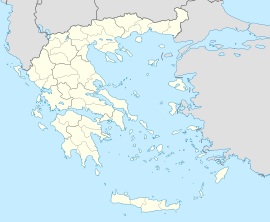You can help expand this article with text translated from the corresponding article in Greek. (January 2019) Click [show] for important translation instructions.
|
Echinos (Greek: Εχίνος; Bulgarian: Шахин, Shahin) is a village and a community in the municipality Myki.[2] Before the 2011 local government reform it was part of the municipality of Myki, of which it was a municipal district.[2] The 2021 census recorded 2,780 inhabitants in the community.[1] The community of Echinos covers an area of 85.691 km2.[3]
Echinos
Εχίνος Шахин | |
|---|---|
 View of Echinos | |
| Coordinates: 41°16.5′N 24°58.3′E / 41.2750°N 24.9717°E | |
| Country | Greece |
| Administrative region | East Macedonia and Thrace |
| Regional unit | Xanthi |
| Municipality | Myki |
| Municipal unit | Myki |
| Area | |
• Community | 85.691 km2 (33.085 sq mi) |
| Elevation | 333 m (1,093 ft) |
| Population (2021)[1] | |
• Community | 2,780 |
| • Density | 32/km2 (84/sq mi) |
| Time zone | UTC+2 (EET) |
| • Summer (DST) | UTC+3 (EEST) |
| Postal code | 673 00 |
| Area code(s) | +30-2544 |
| Vehicle registration | AH |
History
editAccording to the legend Echinos was founded during the 1360s by Lala Shahin Pasha, hence its old name Shahin.[4]
The village is first mentioned in an Ottoman document from the middle of the 16th century. The document lists those who voluntarily took part in Ottoman military operations. According to that document 23 Muslim families and 18 single Muslims from Shahin were involved in those operations. Their incomes are also included in the document for proper taxation.[5]
In the end of the 19th century the renowned explorer of the Rhodope Mountains St. Shishkov traveled through Shahin and wrote about the village that the people were very passionate Muslims and when one meets a woman, she turns her face aside. If you try to talk with her or ask her something, she would call her husband. He also wrote that the village was very rich and even the children used to dress in expensive clothes. The houses were two or three stories all painted in white. Shishkov describes the village more like a little town with some 200 houses.[6]
According to Lyubomir Miletich as of 1912 Shahin was a Pomak village in the Darıdere kaza of the Ottoman Empire.[7] According to Patriarch Cyril as of 1943 there were 417 households and 1975 inhabitants in Shahin - all Pomaks.[8]
Administrative division
editThe community of Echinos consists of two separate settlements:[1]
- Melivoia (population 570)
- Echinos (population 2,210)
Geography
editEchinos lies on a valley of the Rhodope Mountains. It is 761 kilometers northeast of Athens, 254 kilometers northeast of Thessaloniki, and 27 kilometers north northeast of Xanthi.
Population
editThe majority of the population of Echinos are Pomaks.[9]
| Year | Pop. | ±% |
|---|---|---|
| 2001[3] | 2,883 | — |
| 2011[10] | 3,074 | +6.6% |
| 2021[1] | 2,780 | −9.6% |
Notable people
edit- Chafiz Sophologiotatos Tzemali (born 1937-03-10) - a graduate of the Islamic University of Madinah and mufti of Komotini.[11]
References
edit- ^ a b c d "Αποτελέσματα Απογραφής Πληθυσμού - Κατοικιών 2021, Μόνιμος Πληθυσμός κατά οικισμό" [Results of the 2021 Population - Housing Census, Permanent population by settlement] (in Greek). Hellenic Statistical Authority. 29 March 2024.
- ^ a b "ΦΕΚ B 1292/2010, Kallikratis reform municipalities" (in Greek). Government Gazette.
- ^ a b "Population & housing census 2001 (incl. area and average elevation)" (PDF) (in Greek). National Statistical Service of Greece. Archived from the original (PDF) on 2015-09-21.
- ^ "ŞAHİN KÖYÜ". Retrieved 2009-06-22.
- ^ Цветкова, Бистра (1972). Турски извори за българската история. Том 3:2 (in Bulgarian). София: Българска академия на науките. p. 416. OCLC 405458491.
- ^ Шишков, Ст. Н. (1907). "Елидже дереси. — Нощна гледка и впечатления. — Елидженскитѣ ханища и нощуване въ тѣхъ. — Вододѣлъ на Шеинската и Муставшовска рѣки. — Помашкитѣ села Вълканово и Козлуджа. — Пашавикъ и турскитѣ медресета въ Родопитѣ. — Гюкче-бунарь. — Пашовикския долъ и стария кастелъ Мусагенъ. — Муставшовска рѣка. — Змиища.". Изъ Бѣломорската равнина. Пѫтни бѣлѣжки и впечатления отъ Ст. Н. Шишковъ (in Bulgarian). Пловдивъ: Печатница „Трудъ” на П. Бѣловѣждовъ. pp. 19–20. OCLC 25301398. Retrieved 2009-05-15.
- ^ Милетич, Любомир (1918). Разорението на тракийскитѣ българи презъ 1913 година (in Bulgarian). София: Българска Академия на Науките; Държавна Печатница. p. 295. OCLC 404571567. Retrieved 2009-05-15.
- ^ Райчевски, Стоян (2004) [1998]. Българите мохамедани (in Bulgarian) (II ed.). София: Национален музей на българската книга и полиграфия. p. 139. ISBN 954-9308-51-0. OCLC 68572487.
- ^ Hope, Kerin (21 June 2005). "Discrimination fades but isolation stifles Pomak people". Financial Times. Retrieved 9 October 2015.
- ^ "Απογραφή Πληθυσμού - Κατοικιών 2011. ΜΟΝΙΜΟΣ Πληθυσμός" (in Greek). Hellenic Statistical Authority.
- ^ "O Μουφτής". Archived from the original on 2009-04-10. Retrieved 2009-06-22.
